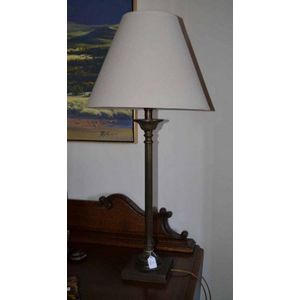Victorian Carved Wooden Music Stand with Brass Column
You must be a subscriber, and be logged in to view price and dealer details.
Subscribe Now to view actual auction price for this item
When you subscribe, you have the option of setting the currency in which to display prices to $Au, $US, $NZ or Stg.
- Pad Foot - In furniture design, a pad foot refers to a type of
furniture foot that is shaped like a flattened ball or pad. It is a common
design element in traditional furniture styles, particularly in English and
American furniture from the 18th and 19th centuries. The pad foot is typically
wider than it is tall, with a broad, flat surface that rests directly on the
floor. It is often carved or turned with decorative details, such as fluting or
ridges, and can be made from a variety of materials, such as wood, metal, or
leather.
Pad feet are used to support the legs of various types of
furniture, such as chairs, tables, and cabinets. They are often used in
combination with other types of feet, such as bun feet or bracket feet, to
create a more complex and decorative furniture design. In terms of
functionality, pad feet provide stability and support to furniture pieces, and
can help distribute the weight of the piece evenly across the floor. In terms
of design, they add a classic and traditional look to furniture designs, and
are often used to create a sense of elegance and refinement. - Victorian Period - The Victorian period of furniture and decorative arts design covers the reign of Queen Victoria from 1837 to 1901. There was not one dominant style of furniture in the Victorian period. Designers used and modified many historical styles such as Gothic, Tudor, Elizabethan, English Rococo, Neoclassical and others, although use of some styles, such as English Rococo and Gothic tended to dominate the furniture manufacture of the period.
The Victorian period was preceded by the Regency and William IV periods, and followed by the Edwardian period, named for Edward VII (1841 ? 1910) who was King of the United Kingdom and the British Dominions and Emperor of India for the brief period from 1901 until his death in 1910. - Column - An architectural feature sometimes used for decorative effect and sometimes as part of the supporting construction. Columns should generally taper slightly towards the top. They may be plain or decorated with carving, fluting or reeding. Columns may be fully rounded or, more commonly, half-rounded and attached with glue, screws or pins to the outer stiles of doors, or the facing uprights on cabinets and bureaux.
This item has been included into following indexes:
- music stands 47
Visually similar items

A Victorian burr elm wine table. Circular form, quarter veneered, on a spiral turned column, with out swept legs, each carved with rosettes. 63 cm high, 63 wide.

A superb Arts & Crafts standard lamp with original turquoise glass shade in the Tiffany style. Height 170 cm, width 45 cm, depth 45 cm

A pair reeded column bronze table lamps. Height 75 cm (with shade)

Early Victorian mahogany adjustable reading table with opposing reading lecterns, circa 1840, column high is adjustable by telescopic ratchet, 73 cm high, 65 cm long 51 cm deep
